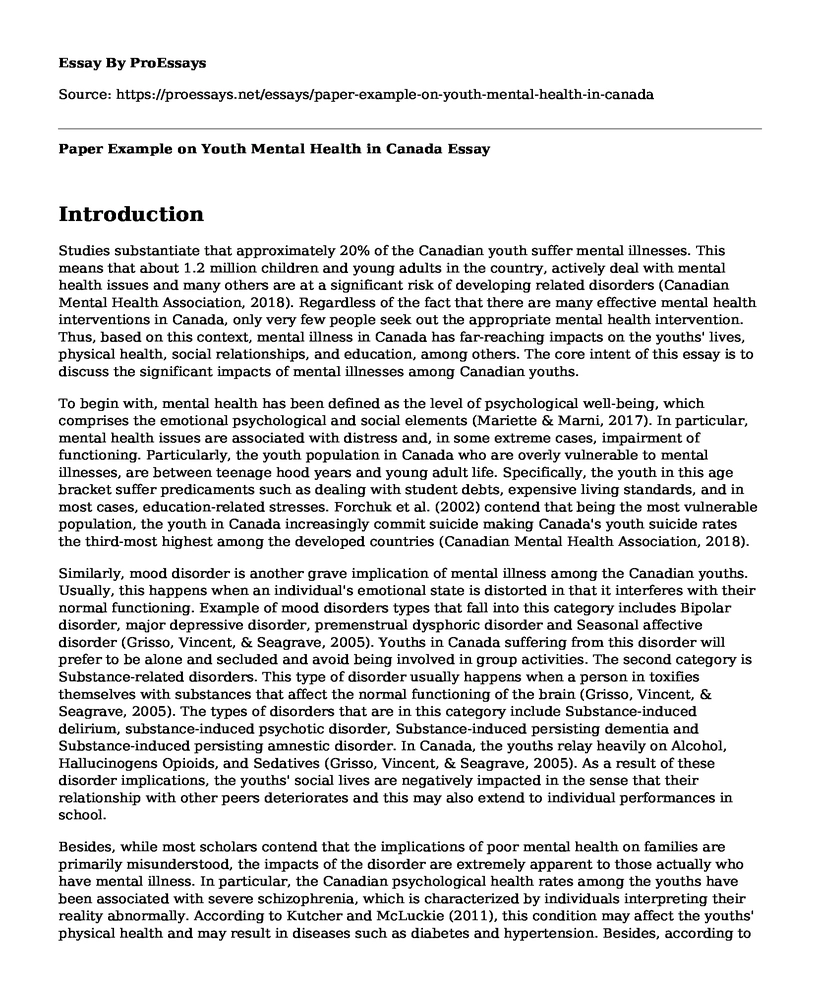Introduction
Studies substantiate that approximately 20% of the Canadian youth suffer mental illnesses. This means that about 1.2 million children and young adults in the country, actively deal with mental health issues and many others are at a significant risk of developing related disorders (Canadian Mental Health Association, 2018). Regardless of the fact that there are many effective mental health interventions in Canada, only very few people seek out the appropriate mental health intervention. Thus, based on this context, mental illness in Canada has far-reaching impacts on the youths' lives, physical health, social relationships, and education, among others. The core intent of this essay is to discuss the significant impacts of mental illnesses among Canadian youths.
To begin with, mental health has been defined as the level of psychological well-being, which comprises the emotional psychological and social elements (Mariette & Marni, 2017). In particular, mental health issues are associated with distress and, in some extreme cases, impairment of functioning. Particularly, the youth population in Canada who are overly vulnerable to mental illnesses, are between teenage hood years and young adult life. Specifically, the youth in this age bracket suffer predicaments such as dealing with student debts, expensive living standards, and in most cases, education-related stresses. Forchuk et al. (2002) contend that being the most vulnerable population, the youth in Canada increasingly commit suicide making Canada's youth suicide rates the third-most highest among the developed countries (Canadian Mental Health Association, 2018).
Similarly, mood disorder is another grave implication of mental illness among the Canadian youths. Usually, this happens when an individual's emotional state is distorted in that it interferes with their normal functioning. Example of mood disorders types that fall into this category includes Bipolar disorder, major depressive disorder, premenstrual dysphoric disorder and Seasonal affective disorder (Grisso, Vincent, & Seagrave, 2005). Youths in Canada suffering from this disorder will prefer to be alone and secluded and avoid being involved in group activities. The second category is Substance-related disorders. This type of disorder usually happens when a person in toxifies themselves with substances that affect the normal functioning of the brain (Grisso, Vincent, & Seagrave, 2005). The types of disorders that are in this category include Substance-induced delirium, substance-induced psychotic disorder, Substance-induced persisting dementia and Substance-induced persisting amnestic disorder. In Canada, the youths relay heavily on Alcohol, Hallucinogens Opioids, and Sedatives (Grisso, Vincent, & Seagrave, 2005). As a result of these disorder implications, the youths' social lives are negatively impacted in the sense that their relationship with other peers deteriorates and this may also extend to individual performances in school.
Besides, while most scholars contend that the implications of poor mental health on families are primarily misunderstood, the impacts of the disorder are extremely apparent to those actually who have mental illness. In particular, the Canadian psychological health rates among the youths have been associated with severe schizophrenia, which is characterized by individuals interpreting their reality abnormally. According to Kutcher and McLuckie (2011), this condition may affect the youths' physical health and may result in diseases such as diabetes and hypertension. Besides, according to various Canadian studies regarding the prevalence schizophrenia, the condition is said to affect approximately one in every 100 youths.
Conclusion
In conclusion, based on the prevalence of mental illness among Canadian youths, there is a need for immediate intervention and encouraging a majority of the youth to seek help. In this regard, the Canadian Health institutions ought to provide medication to the youths who are affected free of charge. This may be done in both public and private hospitals. This, in essence, makes it the responsibility of all people to ensure a mental health youth population.
References
Canadian Mental Health Association. (2018). Fast Facts about Mental Illness - CMHA National. Retrieved from https://cmha.ca/about-cmha/fast-facts-about-mental-illness
Forchuk, C., Ouwerkerk, A., Yamashita, M., & Martin, M. (2002). Mental Health Case Management in Canada: Job Description Analyses. Issues in Mental Health Nursing, 23(5), 477-496. doi:10.1080/01612840290052659
Kutcher, S., & McLuckie, A. (2011). Evergreen: A Child and Youth Mental Health Framework for Canada. PsycEXTRA Dataset, 16(7). doi:10.1037/e504402013-001
Cite this page
Paper Example on Youth Mental Health in Canada. (2022, May 09). Retrieved from https://proessays.net/essays/paper-example-on-youth-mental-health-in-canada
If you are the original author of this essay and no longer wish to have it published on the ProEssays website, please click below to request its removal:
- Personal Success Essay
- Effect of Cell Phone Use on People Essay
- The Relationship Between Emotions or Feelings to Morality
- Essay Sample on Indiana Teens: Substance Abuse & Mental Health Risk
- Primary Sources: Relevance & Evaluation - Essay Sample
- Paper Example on Parental Influence on Child's Social Skills: Impact on Mental Wellness
- Essay on ASPD: Understanding the Role of Social Data Processing in Pathology







